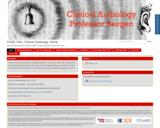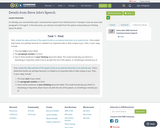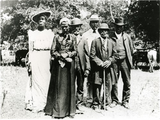
This video offers some advice on using notecards during the types of speeches often given in public speaking classes.
- Subject:
- Business and Communication
- Communication
- Material Type:
- Lecture
- Author:
- Ryan Guy
- Date Added:
- 06/02/2022

This video offers some advice on using notecards during the types of speeches often given in public speaking classes.

Middle and High School educators across Lebanon County, Pennsylvania developed lesson plans to integrate the Pennsylvania Career Education and Work Standards with the content they teach. This work was made possible through a partnership between the South Central PA Workforce Investment Board (SCPa Works) and Lancaster-Lebanon Intermediate Unit 13 (IU13) and was funded by a Teacher in the Workplace Grant Award from the Pennsylvania Department of Labor and Industry. This lesson plan was developed by one of the talented educators who participated in this project during the 2019-2020 school year.

An advanced course covering anatomical, physiological, behavioral, and computational studies of the central nervous system relevant to speech and hearing. Students learn primarily by discussions of scientific papers on topics of current interest. Recent topics include cell types and neural circuits in the auditory brainstem, organization and processing in the auditory cortex, auditory reflexes and descending systems, functional imaging of the human auditory system, quantitative methods for relating neural responses to behavior, speech motor control, cortical representation of language, and auditory learning in songbirds.

This course explores the problem of intelligence—its nature, how it is produced by the brain and how it could be replicated in machines—using an approach that integrates cognitive science, which studies the mind; neuroscience, which studies the brain; and computer science and artificial intelligence, which study the computations needed to develop intelligent machines. Materials are drawn from the Brains, Minds and Machines Summer Course offered annually at the Marine Biological Laboratory in Woods Hole, MA, taught by faculty affiliated with the Center for Brains, Minds and Machines headquartered at MIT. Elements of the summer course are integrated into the MIT course, 9.523 Aspects of a Computational Theory of Intelligence.
Contributors
This course includes the contributions of many instructors, guest speakers, and a team of iCub researchers. See the complete list of contributors.

Evidence-based clinical aspects of audiologic identification, assessment, intervention, and prevention of hearing impairments relevant to the practice of speech-language pathology; strategies for working with individuals and their families across the lifespan; culturally and linguistically appropriate practice.

Course Description: COM218z increases the knowledge and use of competent communication skills to better understand oneself, others, and the role of communication in interpersonal relationships.
Course Outcomes: 1. Describe how culture, identity, perception, biases, and power influence the communication process. 2. Recognize and analyze interpersonal communication concepts (e.g., ethics, verbal and nonverbal communication, listening, emotions, and conflict). 3. Assess one’s own interpersonal skills to become more competent in a variety of relational contexts. 4. Apply foundational concepts and theories to interpersonal communication.

In this video you will learn about the differences between in-text citations and oral citations. In addition, we will cover the four criteria of citing sources orally. Please watch the Citing Sources Orally video (2 min. 36 sec.) below. Closed captions in English are available. Recorded with Adobe Spark. Citing Sources Orally

Let’s consider some common mistakes you should avoid as a presenter.

Course DescriptionStudy of the essential elements of oral communication, with major emphasis on public speaking. Includes use of multimedia technologies for presentations.Course ContentCommunication DisciplineBasic RhetoricSpeech StructureContent DevelopmentSpeech PreparationSpeech AnxietyDelivery Techniques and StylesListeningMulticultural CommunicationSpeech AnalysisCommunication EthicsAudience AnalysisPublic Speaking in Group EnvironmentsIndividual Research Project

STUDENT LEARNING OBJECTIVE: Students will be able to create and deliver a well-researched, informative speech about soybeans, demonstrating their understanding of the crop's importance in agriculture and its impact on various industries.MEASURABLE ACHIEVEMENT GOAL: Students will present a 5-minute informative speech about soybeans, covering at least four of the following aspects: history, cultivation, nutritional value, industrial uses, economic importance, and environmental impact. The speech will be evaluated using a rubric that assesses content accuracy, organization, delivery, and use of visual aids. Lesson written by Allison Johnson, Falls City, NE

On Monday, you scanned Steve Jobs' commencement speech from Stanford and on Tuesday in class we close-read paragraphs 6 through 8. In this discussion, you will post one detail from the speech and provide your thinking about the detail.

The first two weeks of this course are an overview of performing improvisation with introductory and advanced exercises in the techniques of improvisation. The final four weeks focus on applying these concepts in business situations to practice and mastering these improvisation tools in leadership learning.

The 11th grade learning experience consists of 7 mostly month-long units aligned to the Common Core State Standards, with available course material for teachers and students easily accessible online. Over the course of the year there is a steady progression in text complexity levels, sophistication of writing tasks, speaking and listening activities, and increased opportunities for independent and collaborative work. Rubrics and student models accompany many writing assignments.Throughout the 11th grade year, in addition to the Common Read texts that the whole class reads together, students each select an Independent Reading book and engage with peers in group Book Talks. Students move from learning the class rituals and routines and genre features of argument writing in Unit 11.1 to learning about narrative and informational genres in Unit 11.2: The American Short Story. Teacher resources provide additional materials to support each unit.

In this unit, students will explore great works of American literature and consider how writers reflect the time period in which they write. They will write two literary analysis papers and also work in groups to research and develop anthologies of excellent American stories.
ACCOMPLISHMENTS
Students read and analyze stories from several 19th-, 20th-, and 21st-century American authors. After researching a time period, they select stories from that period to create an anthology. The readings enhance their understanding of the short story, increase their exposure to well-known American authors, and allow them to examine the influence of social, cultural, and political context.
Students examine elements of short stories and have an opportunity for close reading of several American short stories. During these close readings, they examine the ways that short story writers attempt to explore the greater truths of the American experience through their literature.
GUIDING QUESTIONS
These questions are a guide to stimulate thinking, discussion, and writing on the themes and ideas in the unit. For complete and thoughtful answers and for meaningful discussions, students must use evidence based on careful reading of the texts.
If you were to write a short story about this decade, what issues might you focus on?
What defines a short story? Just length?
To what extent do these stories reflect the era or decade in which they were written?
To what extent are the themes they address universal?
CLASSROOM FILMS
History.com has short videos on the Vietnam War (“Vietnam” and “A Soldier's Story”).

In this lesson, students will explore dialogue and speech. They'll work with each other to understand the significance of the language and diction we use and consider how we are judged by the way we speak.

In this lesson, students will focus on the use of point of view in the short story. They will re-examine first-person narration in “The Tell-Tale Heart” and also consider third-person narration in Kate Chopin's “Regret.”

The 12th grade learning experience consists of 7 mostly month-long units aligned to the Common Core State Standards, with available course material for teachers and students easily accessible online. Over the course of the year there is a steady progression in text complexity levels, sophistication of writing tasks, speaking and listening activities, and increased opportunities for independent and collaborative work. Rubrics and student models accompany many writing assignments.Throughout the 12th grade year, in addition to the Common Read texts that the whole class reads together, students each select an Independent Reading book and engage with peers in group Book Talks. Language study is embedded in every 12th grade unit as students use annotation to closely review aspects of each text. Teacher resources provide additional materials to support each unit.

This project unit—a multimedia self-portrait published in digital form—is the capstone of your students' high school careers. It is a chance for them to pause and reflect on where they've been, where they're going, and who they are as a person. Students will reflect on what they want others to know about them: what they want their message to be and what types of media they might use to convey that message. Students will have the opportunity to express themselves in many different formats—through writing, of course, but also through other media of their choosing. Students will be able to convey your message through visual art, photography, a graphic novel, audio, poetry, or video—practically any type of media they want!
ACCOMPLISHMENTS
Students will complete a multimedia self-portrait, capturing important aspects of the essence of themselves.
Students will contribute one chapter from their multimedia self-portrait to a class anthology.
Students will present one chapter from their multimedia self-portrait to the class.
GUIDING QUESTIONS
These questions are a guide to stimulate thinking, discussion, and writing on the themes and ideas in the unit. For complete and thoughtful answers and for meaningful discussions, students must use evidence based on careful reading of the texts.
How is late adolescence a moment of internal and external change?
What are the most important qualities of your character—past, present, and future?
How can you portray these key aspects of yourself using multimedia?
BENCHMARK ASSESSMENT: Cold Read
During this unit, on a day of your choosing, we recommend you administer a Cold Read to assess students’ reading comprehension. For this assessment, students read a text they have never seen before and then respond to multiple-choice and constructed-response questions. The assessment is not included in this course materials.

Congratulations! Students have finished and published their final project. Now they will begin to share and present the chapter they included in the class anthology. As their classmates share, they should note what in the presentations stands out. What made a strong impression?

The class will finish the presentations. What new things about the students did the presentations teach them? Were there common themes students noticed in all of the presentations? Did those themes help them draw conclusions about the experience of being a teenager?